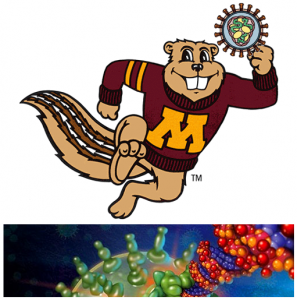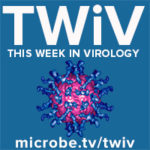Hosts: Vincent Racaniello, Roberto Cattaneo, Reuben Harris, Lou Mansky, and Leslie Schiff
Vincent meets up with Roberto, Reuben, Lou, and Leslie at the University of Minnesota to talk about their work on HIV-1, APOBEC proteins, measles virus, and teaching virology to undergraduates.
Click arrow to play
Download TWiV 232 (60 MB .mp3, 84 min)
Subscribe (free): iTunes, RSS, email
Links for this episode:
- University of Minnesota virology timeline
- Virology and Gene Therapy track at Mayo Clinic
- Revisiting HIV-1 lethal mutagenesis (Trends Micro)
- Exploiting HIV-1 drug repositioning (J Virol)
- 5-azaC induces HIV-1 lethal mutagenesis (J Virol)
- HIV-1 fitness and mutation rate (J Mol Biol)
- APOBEC3 mutagenesis in breast cancer (Nature)
- Restriction factors of HIV (J Biol Chem)
- Nectin-4 is epithelial measles receptor (Nature)
- Photographs of this episode: Click icon below

TWiV 232 - Video of this episode – view above or at YouTube
Send your virology questions and comments (email or mp3 file) to [email protected]



As a virologist (by training) recently embarking on the field of gene therapy, I find the graduate program established by Dr. Cattaneo is very interesting, unique, and important. I have raised this issue before here in TWIV and I hope it can be further discussed in more details and the field is in great need for visionary discussion.
From practical and translational perspective, the concepts of combined virology/gene therapy are not well-orchestrated, and more adequate discussion of this topic – mainly by virologists – is not just important but crucial for the advancement of gene therapy field.
Here is a nice example just recently published (last month) in Nature Medicine highlighting how understanding basic virology concepts have marked consequences on the translational application of gene therapy:
Xu Z, Qiu Q, Tian J, Smith JS, Conenello GM, Morita T, Byrnes AP. Coagulation factor X shields adenovirus type 5 from attack by natural antibodies and complement.Nat Med. 2013 Apr;19(4):452-7.
Abstract
Adenovirus type 5 (Ad5) specifically binds coagulation factor X (FX), and FX is normally essential for intravenously injected Ad5 vectors to transduce the liver. We demonstrate that the ability of FX to enhance liver transduction by Ad5 vectors is due to an unexpected ability of FX to protect Ad5 from attack by the classical complement pathway. In vitro, naive mouse serum neutralized Ad5 when FX was blocked from binding Ad5. This neutralization was mediated by natural IgM and the classical complement pathway. In vivo, FX was essential for Ad5 vectors to transduce the livers of wild-type mice, but FX was not required for liver transduction in mice that lack antibodies, C1q or C4. We conclude that Ad5 recruits FX as a defense against complement and that the sensitivity of Ad5 to inactivation by complement must be taken into account when designing vectors for systemic gene therapy.